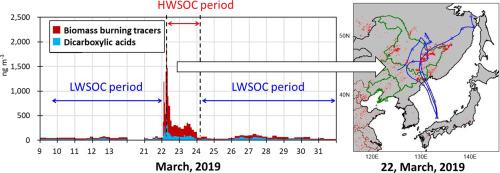Science of the Total Environment ( IF 9.8 ) Pub Date : 2020-09-14 , DOI: 10.1016/j.scitotenv.2020.142183 Fumikazu Ikemori , Katsushige Uranishi , Takahiro Sato , Makoto Fujihara , Hitomi Hasegawa , Seiji Sugata

|
To evaluate the transboundary pollution of organic aerosols from Northeast Asia, a highly time-resolved measurement of organic compounds was performed in March 2019 at Oki Island located in Japan, which is a remote site and less affected by local anthropogenic sources. PM2.5, water-soluble organic carbon (WSOC) concentrations, and WSOC fraction in PM2.5 showed high values on March 22–23 (high-WSOC period (HWSOC)) when the air mass passed through the area where many fire spots were detected in Northeast China. Biomass burning tracers showed higher concentration, especially levoglucosan exceeded 1 μg/m3 during the HWSOC than the low-WSOC period (LWSOC). Notably, high time-resolved measurements of biomass burning tracers and back trajectory analysis during HWSOC revealed a difference in the variation of lignin pyrolyzed compounds and anhydrous sugars on 22 and 23 March. The air mass passed to different areas in Northeast China in which fire spots were detected, such as the eastern area on the 22nd and the western area on the 23rd. Almost-organic compounds also showed high concentration and strong correlations with levoglucosan and sulfate during HWSOC. Moreover, low-carbon dicarboxylic acids (e.g., adipic acid) and secondary products from anthropogenic volatile organic compounds (e.g., 2,3-dihydroxy-4-oxopentanoic, phthalic, 5-nitrosalicylic acids), also showed a strong correlation with sulfate ions during the HWSOC and LWSOC, respectively. These higher concentrations and strong correlations with levoglucosan and sulfate during the HWSOC propose that their generation could be enhanced by biomass burning. The ratios of organics (e.g., levoglucosan/mannnosan, pinic/3-methylbutane-1,2,3-tricarboxylic acids) suggest that the high concentrations of PM2.5 and WSOC observed during the HWSOC were caused by aged organic aerosols that originated from the combustion of herbaceous plants transported from Northeast China. Our findings indicate that biomass combustion in Northeast China could significantly affect the chemical compositions and the characterization of organic aerosols in downwind regions of Northeast China.


























 京公网安备 11010802027423号
京公网安备 11010802027423号